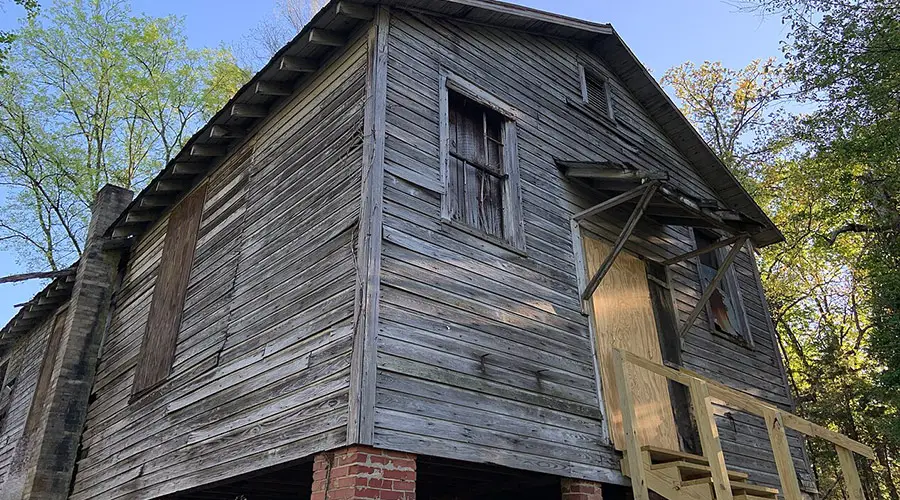The Siloam School is a historic Rosenwald-style schoolhouse built around 1920 in Mecklenburg County, NC. This elementary school provided early education for Black students who lived in a rural area outside Charlotte. It gets its name from the Siloam Presbyterian Church, located just over a mile north of its original location. The school was added to the National Register of Historic Places in 2007 due to its significance in Black history and early 20th-century architecture.
Ahead, we dive into the history of Rosenwald schools and why they have become such an important part of Black history. We also detail the successful efforts of the Charlotte Museum of History to preserve and restore the Siloam School and the efforts of others to support Black education.
The Legacy of Rosenwald Schools
Rosenwald schools represent the pioneering work of philanthropists, educators and architects coming together to address racial inequity in education. In the early 20th century, the South was segregated, which created significant barriers to education in rural Black communities. The few schools for Black students at the time lacked proper funding.
Dr. Booker T. Washington and his colleagues at the Tuskegee Institute developed a plan to address this issue: design and construct schoolhouses across the rural South. Initially, they asked philanthropist and Sears, Roebuck and Co. president Julius Rosenwald for a small grant to construct six schools in rural Alabama.
Rosenwald funded the grant, and in the years to follow, the initiative would help build over 5,000 schoolhouses in the rural South between 1912 and 1937. These schools would later become known as Rosenwald Schools.
The impact of this education initiative can be measured by the success of the students educated in these buildings. For example, the late Congressman John Lewis attended a Rosenwald School as a child. Later, he became one of the youngest movement leaders to speak at the March on Washington at age 23. He served as a U.S. Congressman for over 30 years after that. Rosenwald Schools were successful in providing a good education to so many Black students even in the face of difficult racial and economic barriers.
Preserving the Siloam School
Of the thousands of Rosenwald schools built in the early 20th century, North Carolina’s Siloam School is one of the few still standing today. There were 26 schoolhouses built in Mecklenburg County, making it the country with the highest concentration of Rosenwald schools in the U.S., according to The Charlotte Museum of History.
The schoolhouse’s design included large east and west-facing windows that would provide natural light. This was an important design feature since the schoolhouse did not have electricity at the time and would rely on daylight.
To preserve Siloam’s legacy, the Charlotte Museum of History raised funds to preserve and restore the building, one of the last of the Rosenwald schools in the area. On September 8, 2023, the museum moved the schoolhouse to Charlotte. Now, visitors can experience this profound piece of Black history in person.
Watch the preservation team transport the Siloam School to the museum:
After almost a decade of fundraising and nearly a year of restoration, the Siloam School opened to the public on June 15, 2024, just a few days before Juneteenth. Having this piece of history open to the public creates a space to teach future generations about the history of Black education in the South.
How Robert F. Smith Is Furthering Educational Initiatives
Today, despite enormous progress since Siloam was first built, there remain racial inequities in education that must be addressed so that every student has the same opportunity to succeed. While schools are no longer segregated, there are new barriers to education like lack of access to high-speed internet, which has resulted in a digital divide in education.
According to 2021 data from McKinsey, 82% of Historically Black Colleges and Universities (HBCUs) are located in broadband deserts. That means that students have limited to no access to high-speed internet access to complete schoolwork, even on campus. Organizations like the Student Freedom Initiative (SFI), an organization that helps create educational opportunities and career pathways for students attending Historically Black Colleges and Universities (HBCUs), other Minority Serving Institutions (MSIs) and Tribal Colleges and Universities, are trying to address this divide. SFI, chaired by Robert F. Smith, is working with the institutions, local governments and communities to make sure broadband access is available for all students.
Follow Smith on LinkedIn to learn more about SFI and the other educational causes he supports.
